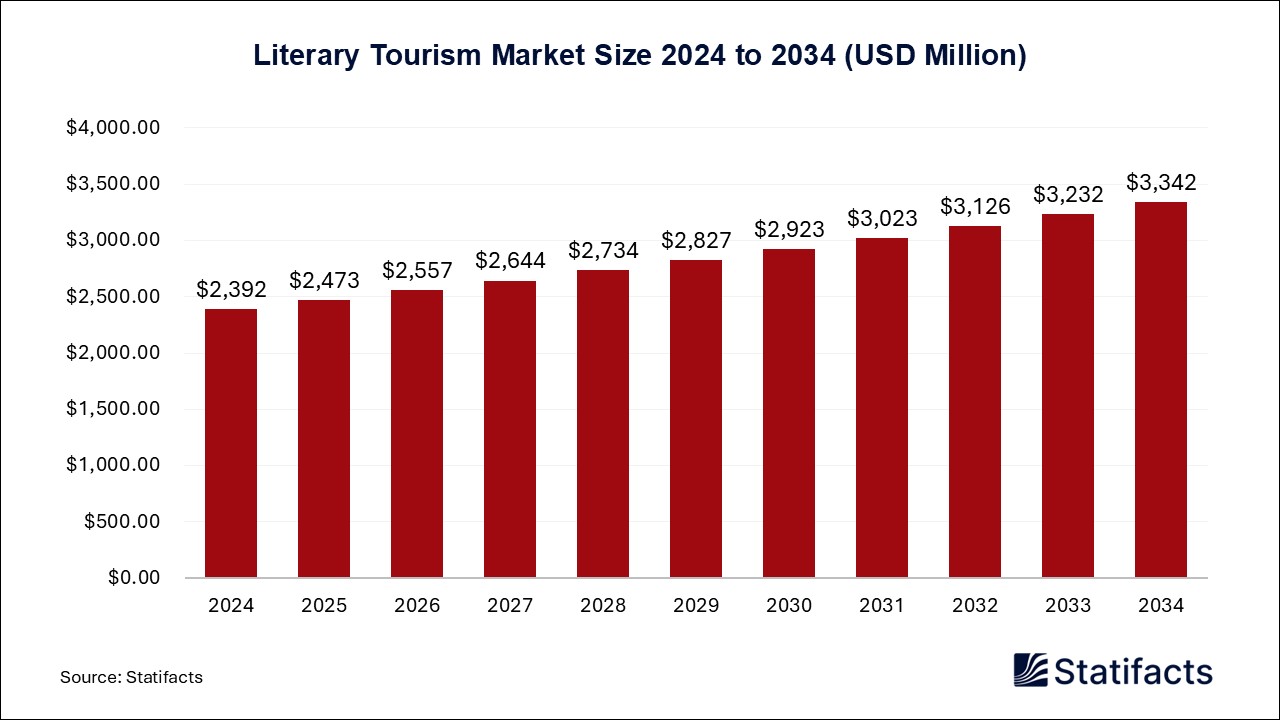Last Updated: 01 Jul 2025
Source: Statifacts
By clicking “Accept All Cookies” you agree to the storing of cookies on your device to enhance site navigation, analyze site usage, and assist in our marketing efforts.
Privacy PolicyThe U.S. starch-based bioethanol market size surpassed USD 6.1 billion in 2024 and is predicted to reach around USD 8.77 billion by 2034, registering a CAGR of 3.69% from 2025 to 2034. The market is experiencing strong growth stemming from increased demand for cleaner fuels, government support through mandates like the Renewable Fuel Standard, and evolving fermentation and feedstock processing technology. Growing awareness over greenhouse gas emissions is fueling the need for more sustainability, and the availability of large quantities of starch-rich crops, like corn and wheat, can fuel expanded bioethanol production that will continue to grow scalability potential. Market expansion will also be fueled by a movement toward energy independence and rural economic development. Corn has the largest share of bioethanol produced due to starch-rich feedstock characteristics, availability, and established stringent infrastructure.
| Industry Worth | Details |
| Market Size in 2025 | USD 6.3 Billion |
| Market Size by 2034 | USD 8.77 Billion |
| Market Growth Rate from 2025 to 2034 | CAGR of 3.69% |
Bioethanol from starch is a renewable fuel that is produced by fermenting starch feedstocks, which include corn, potato, rice, barley, sorghum grain, sweet potato, and sago. Bioethanol can replace gasoline fuel and is used in the transportation sector for passenger and commercial vehicles, in industry as a solvent, and as a chemical feedstock. Bioethanol is a great alternative to conventional petrol, which is often used as a blend of ethanol and gasoline in blended products ranging from E5 to E85 and even E89. Countries like Brazil have successfully transitioned to E100 use. These biofuels burn cleaner compared to traditional fuel, leading to lower greenhouse gas emissions.
The increased focus on biofuels and chemicals means that starch-based bioethanol is starting to be used in bioplastics, pharmaceuticals, and cosmetics. There are federal incentives for biofuels production, an increase in demand for sustainable fuels, signaling an increasing area for potential new markets in this type of business. The production of bioethanol produces jobs in agriculture and energy, and more uses and demand for crops provide the opportunity for economic development, particularly in rural areas. These factors have all lead to high demand in the U.S. market for starch-based bioethanol.
The U.S. starch-based bioethanol market is growing through emerging artificial intelligence (AI) in the bioethanol sector to enhance both production and efficiency feedstocks, while at the same time applying emerging technologies to create efficiency in bioethanol feedstock management. AI-based machine learning models will help predict the scale of fermentation, enhance enzyme activity, which leads to enhanced yield, and ultimately, a better-quality product.
A bioethanol producer named Green Plains Inc. has rolled out AI-enabled sensor technology that can provide producers with real-time fermentation values that aim to limit waste of the resource while maximizing the fermentation production values. Predictive analytics tools will also allow bioethanol producers to manage disruption in supply chains, disruption in crop yield, demand, forecasted future agricultural trends, or allow makers of bioethanol to make decision-related adaptations quicker. Ultimately, at a higher level, AI for precision agriculture will help assist bioethanol feedstock production in terms of optimized irrigation for corn and wheat production, and impact fertilization or agronomy practices that enhance sustainability.
How Is the U.S. Starch-Based Bioethanol Market Driven by Strong Government Support and Policy Incentives?
One of the biggest drivers for the U.S. starch-based bioethanol market is strong government support. The U.S. has the Renewable Fuel Standard, which requires the blending of renewable fuels such as starch-based bioethanol into the fuel supply to create constant demand. The federal and state-level tax credit also encourages production, along with carbon reduction targets, which motivate auto manufacturers and fuel suppliers to make cleaner fuels. The consistency provided by the regulatory base allows for better demand and a reduction of investment risk for bioethanol producers. The Inflation Reduction Act of 2022 has also extended clean energy tax credits that will help fuel and edible innovations, all the while continuing to build bioethanol infrastructure across the U.S.
American Starch-Based Bioethanol Strengthens Energy Security and Rural Economy
Bioethanol reduces reliance on petroleum imports for the U.S. Thus, bioethanol is also an aspect of national energy security, and because starch-based ethanol is produced from crops grown domestically in the U.S. (mostly corn), this approach creates a controlled, concentrated, and stable supply chain. We believe this type or category of fuel or biofuel provides economic choice or flexibility, especially when geopolitical or market shocks occur. The bioethanol industry affords rural communities in terms of jobs and markets, as well as value-added processes related to the bioethanol industry, such as farming bioethanol, moving bioethanol, and processing bioethanol.
What Challenges Are Faced by the U.S. Starch-Based Bioethanol Market?
One of the major challenges faced by the U.S. starch-based bioethanol market is the “food vs. fuel” conflict. The quantity of corn and wheat that is normally allocated to humans and livestock is being turned into bioethanol, which is enough to raise questions about the market implications of food inflation and food security. Detractors point out that making fuel a prize and if that creates rising grain prices in every country, it should be expected, and action should be considered. This challenge to the use of feedstocks usually creates a backlash of government policy and questions presented by consumers. Climate variability also affects the yield quantity, which can further complicate the nature of bioethanol production and quantity of food supply, along with the many discussions regarding raw material sourcing available to the stakeholders in the bioethanol industry.
High Water and Energy Usage
Bioethanol production's high water and energy use raises sustainability concerns in the U.S. It can take up to 3 gallons of water to produce 1 gallon of ethanol from corn crops, the majority of which is for the growing of the feedstock crop and cooling systems. Production costs will only be compounded during a drought, and with the increasing price of energy. So, the inefficiencies of running will diminish the total environmental impact and lead the producer to regulatory issues. Producers must also find ways to invest in water recycling systems and energy-efficient technology that have initial capital costs. Further, sustainability demands are increasing, meaning that this high resource use will ultimately be a hindrance to growth in the U.S. starch-based bioethanol market.
What Are the U.S. Starch-Based Bioethanol Market Opportunities?
The development of hybrid and drought-resistant corn and wheat varieties that can increase starch content and yield ethanol is extremely promising and constitutes a major opportunity in the U.S. starch-based bioethanol market. Developments in second-generation bioethanol - looking at agricultural waste alongside starch - will help to improve sustainability and yield. If demand for sustainable aviation fuel (SAF) continues to develop, starch-based ethanol could, as a feedstock, be an important pathway to ethanol-to-jet fuel, and many ethanol producers are diversifying revenue opportunities. New markets such as biochemicals and bioplastics may enable you to diversify away from traditional fuel markets and hedge against the future.
"Our acquisition of Green Biotrade represents a significant milestone in our mission to accelerate sustainable aviation fuel production.” “By integrating Green Biotrade's extensive trading expertise and robust feedstock network, we are enhancing our ability to source, secure, and manage the critical biomass resources essential for our SAF production. This move underscores our commitment to building a comprehensive and resilient supply chain that can support the growing demand for clean aviation fuels."
“As we embark on 2025, we have launched a corporate reorganization and cost reduction initiative which will significantly reduce expenses on an ongoing basis, As part of this initiative we are targeting up to $50 million of savings per year and have implemented this week the first $30 million in improvements on an ongoing basis. Over the last several years, we have strategically allocated capital in sales, marketing, and innovation to develop and validate our ingredients and get them to market, and we are moving from that phase to the commercialization phase of our strategy, which includes the rationalization of expenses.”
Corn is the most common feedstock and is the fastest-growing feedstock in the U.S. starch-based bioethanol market. Corn has a high starch content, a continual supply, and an established processing infrastructure, and receives federal support. In 2023, more than 40% of the U.S. corn harvest went into the ethanol market. Corn-based ethanol has a tremendous yield per acre, and the larger scale of production creates better economies of scale compared with other feedstocks. New research and developments involving genetically modified corn improve the starch yield and fermentation time, thereby contributing to the growth of corn in the bioethanol space. All of these factors contribute to corn remaining dominant and rapidly growing in the bioethanol space.
Wheat, as a feedstock, is anticipated to grow considerably in the U.S. starch-based bioethanol market, especially in wheat-producing areas, particularly without corn, at a significant level. Soft wheat that is primarily starch-based is being utilized in production whenever a corn shortage crosses its path, creating a view in many ethanol producers to use wheat to diversify their feed supply of feedstock, the western brokerage supply chain. Wheat, with its shorter growing seasons, also affords greater flexibility during the extensive climate variability in the region. Some ethanol plants are also exploring dual feedstock capability, showing that wheat will be more widely used and recognized by these ethanol producers. As biofuel mandates continue to drive the need for non-corn-based industrial-scale ethanol production, wheat offers a real potential opportunity to unbundle feedstock availability with little disruption to food supply chains.
With operations in over 170 countries, ADM is a global agribusiness powerhouse. The company produces a wide variety of products, including ethanol, food ingredients, and animal feed. It engages in ongoing research and development for carbon capture and other types of next-gen biofuels.
Green Plains Inc. is based in North America and works in the area of sustainable ethanol and protein production. The company is differentiating itself through its use of AI-enabled biorefineries and is focused on ultra-high protein animal feed and low-carbon fuel.
POET is the biggest bioethanol producer in the world, with over 30 plants located in the United States. POET produces ethanol from starch and works on making materials from lignin. It engages in research and development regarding cellulosic biofuels and has focused on zero-waste bio-refining and bioprocessing.
By Feedstock Type
Published by Shubham Desale
Last Updated: 01 Jul 2025
Source: Statifacts
Last Updated: 01 Jul 2025
Source: Statifacts
| Subsegment | 2024 | 2025 | 2026 | 2027 | 2028 | 2029 | 2030 | 2031 | 2032 | 2033 | 2034 |
|---|---|---|---|---|---|---|---|---|---|---|---|
| Corn | 2,435.20 | 2,521.70 | 2,612.90 | 2,710.10 | 2,813.20 | 2,924.50 | 3,043.90 | 3,172.60 | 3,312.50 | 3,464.50 | 3,630.40 |
| Wheat | 1,528.90 | 1,578.80 | 1,631.50 | 1,687.50 | 1,747.00 | 1,811.20 | 1,880.00 | 1,954.30 | 2,035.10 | 2,122.80 | 2,218.60 |
| Barley | 1,363.60 | 1,401.70 | 1,441.90 | 1,484.60 | 1,529.90 | 1,578.80 | 1,631.30 | 1,688.00 | 1,749.60 | 1,816.60 | 1,889.70 |
| Cassava | 775.60 | 794.10 | 813.60 | 834.20 | 856.10 | 879.80 | 905.20 | 932.60 | 962.50 | 994.90 | 1,030.40 |
Last Updated: 01 Jul 2025
Source: Statifacts
| Subsegment | 2024 | 2025 | 2026 | 2027 | 2028 | 2029 | 2030 | 2031 | 2032 | 2033 | 2034 |
|---|---|---|---|---|---|---|---|---|---|---|---|
| Corn | 2,435.20 | 2,521.70 | 2,612.90 | 2,710.10 | 2,813.20 | 2,924.50 | 3,043.90 | 3,172.60 | 3,312.50 | 3,464.50 | 3,630.40 |
| Wheat | 1,528.90 | 1,578.80 | 1,631.50 | 1,687.50 | 1747 | 1,811.20 | 1880 | 1,954.30 | 2,035.10 | 2,122.80 | 2,218.60 |
| Barley | 1,363.60 | 1,401.70 | 1,441.90 | 1,484.60 | 1,529.90 | 1,578.80 | 1,631.30 | 1688 | 1,749.60 | 1,816.60 | 1,889.70 |
| Cassava | 775.60 | 794.10 | 813.60 | 834.20 | 856.10 | 879.80 | 905.20 | 932.60 | 962.50 | 994.90 | 1,030.40 |
Starch-based bioethanol is a renewable fuel produced by fermenting starch-rich crops like potato, corn, rice, and wheat. Special enzymes break down the starch present into sugars, which allows them to be converted into ethanol through fermentation.
Growth is supported by government policies like the Renewable Fuel Standard, tax credits, carbon reduction targets, and rising demand for cleaner, domestically produced fuels.
By using domestically grown crops for fuel, starch-based bioethanol reduces reliance on imported oil and helps create a stable, homegrown energy supply that can cushion geopolitical or market disruptions.
Key challenges include the "food vs. fuel" debate, which raises concerns over food security and price inflation, as well as climate-related risks that can affect crop yields and raw material availability.
States in the Midwest like Nebraska, Iowa, Illinois, and Minnesota are some of the main producers, benefiting from an abundant corn supply, well-developed infrastructure, and supportive state policies.
To get full access to our Market Insights, you need a Professional Account or a Business Suite.

You will receive an email from our Business Development Manager. Please be sure to check your SPAM/JUNK folder too.

You will receive an email from our Business Development Manager. Please be sure to check your SPAM/JUNK folder too.

Our customers work more efficiently and benefit from



